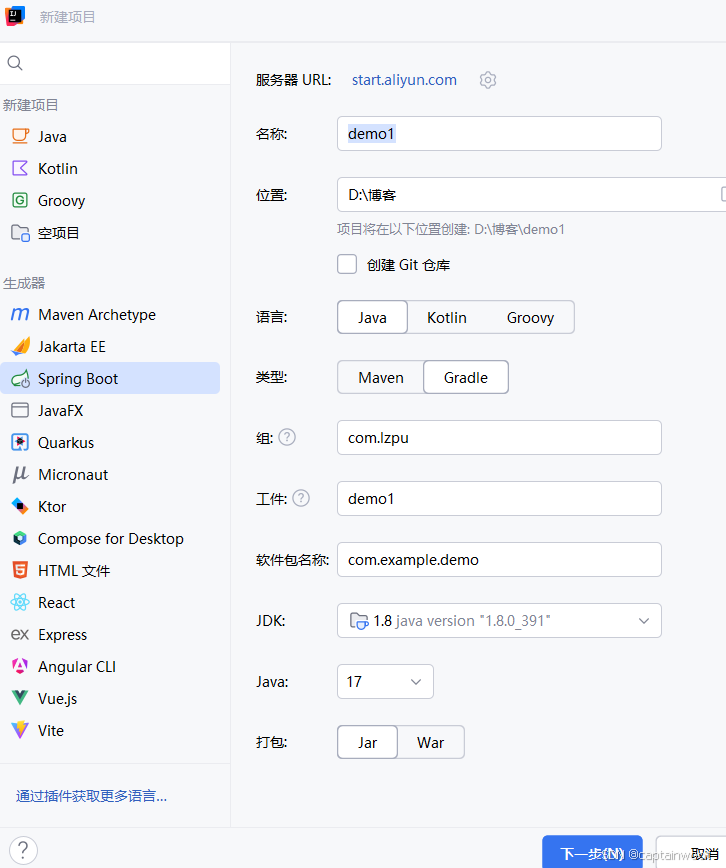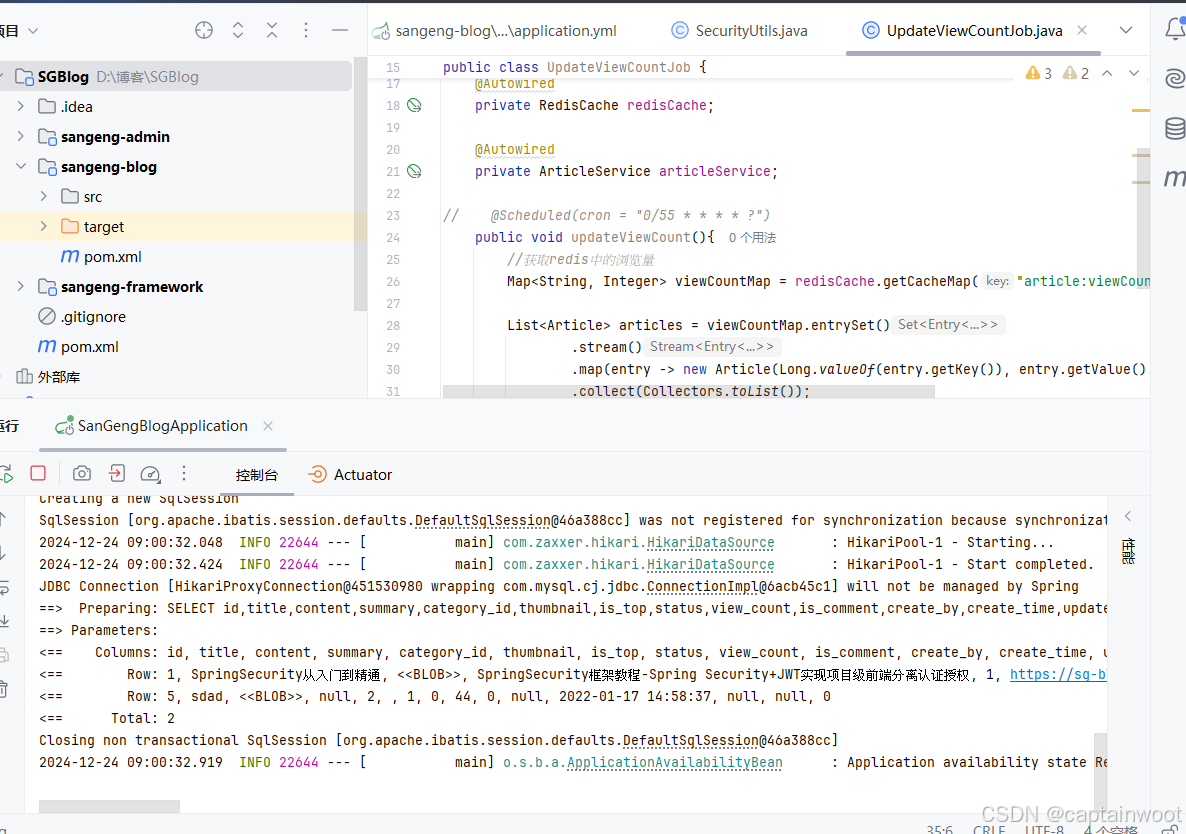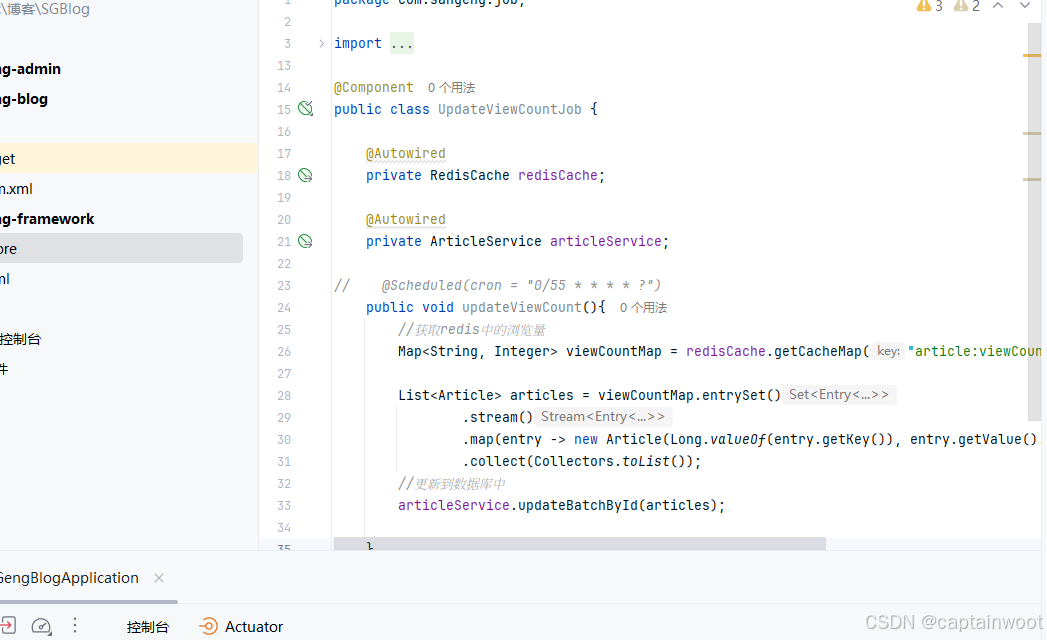SpringBoot应用开发实战:从零到一构建项目
在当今的软件开发领域,Spring Boot凭借其快速开发、简化配置、内嵌服务器等特性,成为了构建Java应用的首选框架。本文将带你从配置开发环境开始,逐步深入Spring Boot应用开发的核心领域,包括快速搭建项目、整合持久层框架、数据缓存管理、RESTful接口设计、权限与安全控制、消息与任务管理、项目开发流程、接口测试与单元测试等多个方面,最终通过一个前后端分离的博客系统案例,展示如何将所学应用于实际项目中。
一、配置开发环境
1. JDK安装
Java Development Kit(JDK)是Java编程的基础,包含了Java运行环境(JRE)和Java编译器。首先,从Oracle官网或OpenJDK网站下载并安装最新版本的JDK。安装完成后,配置环境变量,确保在命令行中能够使用java和javac命令。
2. Maven安装
Maven是一个Java项目管理和构建工具,可以自动化构建过程,管理项目依赖。从Maven官网下载并解压后,配置M2_HOME环境变量,并将Maven的bin目录添加到系统PATH中。
3. IntelliJ IDEA安装
IntelliJ IDEA是JetBrains公司开发的一款强大的Java集成开发环境(IDE),支持智能代码补全、代码重构、调试等多种功能。从JetBrains官网下载并安装最新版本的IDEA Community或Ultimate版。
4. 配置IDEA中的Maven
打开IDEA,进入File -> Settings -> Build, Execution, Deployment -> Build Tools -> Maven,设置Maven的安装路径和用户设置文件(settings.xml)的路径。
5. 配置JDK
同样在File -> Settings -> Project: [Your Project Name] -> Project SDK中,选择已安装的JDK版本。
二、快速搭建SpringBoot项目
1. 使用Spring Initializr创建项目
Spring Initializr是一个在线工具,可以快速生成Spring Boot项目的基础结构。访问https://start.spring.io/,选择项目构建工具(Maven或Gradle)、语言(Java)、Spring Boot版本,添加所需依赖(如Spring Web、Spring Data JPA等),然后点击“Generate”按钮下载项目压缩包。
2. 解压并导入IDEA
解压下载的项目压缩包,然后在IDEA中选择File -> Open,导入解压后的项目文件夹。IDEA会自动识别并配置Maven项目。
3. 项目结构
Spring Boot项目通常包含以下目录和文件:
src/main/java:Java源代码目录,按照包结构组织。src/main/resources:资源文件目录,包含配置文件(如application.properties或application.yml)、静态资源(如HTML、CSS、JS文件)等。src/test/java:测试代码目录,与src/main/java对应,用于编写单元测试。pom.xml:Maven项目对象模型文件,定义了项目的依赖、插件等。
4. 编写Hello World应用
在src/main/java目录下,找到主应用程序类(通常命名为[Your Project Name]Application),并在其中添加一个简单的REST控制器:
java复制代码
package com.example.demo; | |
import org.springframework.boot.SpringApplication; | |
import org.springframework.boot.autoconfigure.SpringBootApplication; | |
import org.springframework.web.bind.annotation.GetMapping; | |
import org.springframework.web.bind.annotation.RestController; | |
@SpringBootApplication | |
public class DemoApplication { | |
public static void main(String[] args) { | |
SpringApplication.run(DemoApplication.class, args); | |
} | |
@RestController | |
class HelloController { | |
@GetMapping("/hello") | |
public String hello() { | |
return "Hello, Spring Boot!"; | |
} | |
} | |
} |
运行DemoApplication类的main方法,启动Spring Boot应用程序。打开浏览器,访问http://localhost:8080/hello,应能看到“Hello, Spring Boot!”的响应。
三、整合持久层框架
在Spring Boot中,整合持久层框架可以方便地进行数据库操作。本文将介绍MyBatis和Spring Data JPA两种流行的持久层框架。
1. 整合MyBatis
1.1 添加依赖
在pom.xml中添加MyBatis和数据库驱动的依赖:
xml复制代码
<dependencies> | |
<!-- Other dependencies --> | |
<dependency> | |
<groupId>org.mybatis.spring.boot</groupId> | |
<artifactId>mybatis-spring-boot-starter</artifactId> | |
<version>2.2.0</version> | |
</dependency> | |
<dependency> | |
<groupId>mysql</groupId> | |
<artifactId>mysql-connector-java</artifactId> | |
<scope>runtime</scope> | |
</dependency> | |
</dependencies> |
1.2 配置数据源
在application.properties或application.yml中配置数据源信息:
properties复制代码
spring.datasource.url=jdbc:mysql://localhost:3306/your_database?useSSL=false&serverTimezone=UTC | |
spring.datasource.username=your_username | |
spring.datasource.password=your_password | |
spring.datasource.driver-class-name=com.mysql.cj.jdbc.Driver | |
mybatis.mapper-locations=classpath:mapper/*.xml |
1.3 创建实体类和Mapper接口
在src/main/java下创建相应的包结构,如com.example.demo.entity和com.example.demo.mapper,并分别创建实体类和Mapper接口。
java复制代码
// User.java | |
package com.example.demo.entity; | |
public class User { | |
private Long id; | |
private String name; | |
private String email; | |
// Getters and Setters | |
} | |
// UserMapper.java | |
package com.example.demo.mapper; | |
import com.example.demo.entity.User; | |
import org.apache.ibatis.annotations.Mapper; | |
import org.apache.ibatis.annotations.Select; | |
import java.util.List; | |
@Mapper | |
public interface UserMapper { | |
@Select("SELECT * FROM users") | |
List<User> findAll(); | |
} |
1.4 使用Mapper接口
在Service或Controller中注入Mapper接口,并调用其方法。
java复制代码
// UserService.java | |
package com.example.demo.service; | |
import com.example.demo.entity.User; | |
import com.example.demo.mapper.UserMapper; | |
import org.springframework.beans.factory.annotation.Autowired; | |
import org.springframework.stereotype.Service; | |
import java.util.List; | |
@Service | |
public class UserService { | |
@Autowired | |
private UserMapper userMapper; | |
public List<User> getAllUsers() { | |
return userMapper.findAll(); | |
} | |
} | |
// UserController.java | |
package com.example.demo.controller; | |
import com.example.demo.entity.User; | |
import com.example.demo.service.UserService; | |
import org.springframework.beans.factory.annotation.Autowired; | |
import org.springframework.web.bind.annotation.GetMapping; | |
import org.springframework.web.bind.annotation.RestController; | |
import java.util.List; | |
@RestController | |
public class UserController { | |
@Autowired | |
private UserService userService; | |
@GetMapping("/users") | |
public List<User> getUsers() { | |
return userService.getAllUsers(); | |
} | |
} |
2. 整合Spring Data JPA
2.1 添加依赖
在pom.xml中添加Spring Data JPA和数据库驱动的依赖:
xml复制代码
<dependencies> | |
<!-- Other dependencies --> | |
<dependency> | |
<groupId>org.springframework.boot</groupId> | |
<artifactId>spring-boot-starter-data-jpa</artifactId> | |
</dependency> | |
<dependency> | |
<groupId>mysql</groupId> | |
<artifactId>mysql-connector-java</artifactId> | |
<scope>runtime</scope> | |
</dependency> | |
</dependencies> |
2.2 配置数据源
数据源配置与MyBatis相同,参考上一节。
2.3 创建实体类和Repository接口
在src/main/java下创建相应的包结构,如com.example.demo.entity和com.example.demo.repository,并分别创建实体类和Repository接口。
java复制代码
id;
private String name;
private String email;
复制代码
// Getters and Setters |
}
// UserRepository.java
package com.example.demo.repository;
import com.example.demo.entity.User;
import org.springframework.data.jpa.repository.JpaRepository;
import org.springframework.stereotype.Repository;
import java.util.List;
@Repository
public interface UserRepository extends JpaRepository<User, Long> {
// 自定义查询方法可以在这里定义,例如根据用户名查找用户
// List<User> findByName(String name);
}
2.4 使用Repository接口
在Service或Controller中注入Repository接口,并调用其方法。
java
// UserService.java
package com.example.demo.service;
import com.example.demo.entity.User;
import com.example.demo.repository.UserRepository;
import org.springframework.beans.factory.annotation.Autowired;
import org.springframework.stereotype.Service;
import java.util.List;
@Service
public class UserService {
复制代码
@Autowired | |
private UserRepository userRepository; | |
public List<User> getAllUsers() { | |
return userRepository.findAll(); | |
} | |
// 可以添加其他业务逻辑方法,例如添加、删除、更新用户等 |
}
// UserController.java
package com.example.demo.controller;
import com.example.demo.entity.User;
import com.example.demo.service.UserService;
import org.springframework.beans.factory.annotation.Autowired;
import org.springframework.web.bind.annotation.GetMapping;
import org.springframework.web.bind.annotation.RestController;
import java.util.List;
@RestController
public class UserController {
复制代码
@Autowired | |
private UserService userService; | |
@GetMapping("/users") | |
public List<User> getUsers() { | |
return userService.getAllUsers(); | |
} | |
// 可以添加其他REST接口,例如添加、删除、更新用户的接口 |
}
三、数据缓存管理
在Spring Boot中,可以使用多种缓存技术来提高数据访问性能,如Ehcache、Caffeine、Redis等。本文将介绍如何在Spring Boot中整合Redis进行数据缓存管理。
- 添加依赖
在pom.xml中添加Spring Boot Redis的依赖:
xml
<dependencies>
<!-- Other dependencies -->
<dependency>
<groupId>org.springframework.boot</groupId>
<artifactId>spring-boot-starter-data-redis</artifactId>
</dependency>
<dependency>
<groupId>redis.clients</groupId>
<artifactId>jedis</artifactId>
</dependency>
</dependencies>
- 配置Redis
在application.properties或application.yml中配置Redis连接信息:
properties
spring.redis.host=localhost
spring.redis.port=6379
- 启用缓存支持
在主应用程序类上添加@EnableCaching注解来启用缓存支持:
java
@SpringBootApplication
@EnableCaching
public class DemoApplication {
// ...
}
- 配置缓存管理器
创建一个配置类来配置Redis缓存管理器:
java
import org.springframework.cache.annotation.EnableCaching;
import org.springframework.cache.interceptor.KeyGenerator;
import org.springframework.context.annotation.Bean;
import org.springframework.context.annotation.Configuration;
import org.springframework.data.redis.cache.RedisCacheConfiguration;
import org.springframework.data.redis.cache.RedisCacheManager;
import org.springframework.data.redis.connection.RedisConnectionFactory;
import org.springframework.data.redis.serializer.GenericJackson2JsonRedisSerializer;
import org.springframework.data.redis.serializer.RedisSerializationContext.SerializationPair;
import java.time.Duration;
@Configuration
@EnableCaching
public class CacheConfig {
复制代码
@Bean | |
public RedisCacheManager cacheManager(RedisConnectionFactory redisConnectionFactory) { | |
RedisCacheConfiguration cacheConfiguration = RedisCacheConfiguration.defaultCacheConfig() | |
.entryTtl(Duration.ofMinutes(10)) | |
.serializeValuesWith(SerializationPair.fromSerializer(new GenericJackson2JsonRedisSerializer())); | |
return RedisCacheManager.builder(redisConnectionFactory) | |
.cacheDefaults(cacheConfiguration) | |
.transactionAware() | |
.build(); | |
} | |
// 自定义Key生成策略,可选 | |
@Bean | |
public KeyGenerator simpleKeyGenerator() { | |
return (target, method, params) -> { | |
StringBuilder sb = new StringBuilder(); | |
sb.append(target.getClass().getSimpleName()); | |
sb.append("."); | |
sb.append(method.getName()); | |
sb.append("("); | |
for (Object obj : params) { | |
sb.append(obj.toString()); | |
} | |
sb.append(")"); | |
return sb.toString(); | |
}; | |
} |
}
- 使用缓存注解
在Service类的方法上使用@Cacheable注解来启用缓存:
java
import org.springframework.cache.annotation.Cacheable;
import org.springframework.stereotype.Service;
import java.util.List;
@Service
public class UserService {
复制代码
// ... 其他代码 | |
@Cacheable(value = "usersCache", keyGenerator = "simpleKeyGenerator") | |
public List<User> getAllUsers() { | |
// 模拟从数据库获取用户列表的复杂操作 | |
// 实际上这里应该调用UserRepository的findAll方法 | |
return List.of(new User(1L, "John Doe", "john.doe@example.com"), | |
new User(2L, "Jane Smith", "jane.smith@example.com")); | |
} |
}
现在,当用户第一次访问/users端点时,服务将执行getAllUsers方法并缓存结果。在缓存过期之前,如果用户再次访问该端点,服务将从缓存中提供结果,而不是再次执行数据库查询。
四、RESTful接口设计
RESTful接口设计是构建现代Web应用的关键部分。在Spring Boot中,可以很容易地创建RESTful接口,通过使用@RestController和@RequestMapping注解。
-
设计RESTful资源
确定你的应用将要暴露哪些资源(例如用户、帖子、评论等),并为每个资源定义标准的CRUD操作(创建、读取、更新、删除)。 -
使用HTTP方法和路径
为每个操作选择合适的HTTP方法(GET、POST、PUT、DELETE)和路径。例如,GET /users 用于获取用户列表,POST /users 用于创建新用户,GET /users/{id} 用于获取特定用户,PUT /users/{id} 用于更新用户,DELETE /users/{id} 用于删除用户。 -
使用@RestController和@RequestMapping
在Spring Boot中,使用@RestController注解来标记一个类作为REST控制器,并使用@RequestMapping注解来定义请求映射。 -
响应体和状态码
确保你的REST接口返回适当的HTTP状态码和响应体。例如,成功创建资源时返回201 Created状态码和资源的表示,成功获取资源时返回200 OK状态码和资源的表示,资源未找到时返回404 Not Found状态码等。 -
使用@RequestBody和@ResponseBody
使用@RequestBody注解来自动将请求体绑定到Java对象,使用@ResponseBody注解来自动将Java对象转换为响应体。在Spring Boot中,当使用@RestController注解时,@ResponseBody注解是隐含的,因此通常不需要显式添加。 -
分页和排序
对于可能返回大量数据的操作(例如获取用户列表),实现分页和排序功能是很重要的。可以使用Spring Data JPA提供的Pageable和Sort接口来实现这一点。 -
异常处理
为你的REST接口实现全局异常处理,以便在发生错误时返回一致的错误响应。可以使用@ControllerAdvice和@ExceptionHandler注解来实现这一点。 -
使用Swagger进行API文档化
Swagger是一个流行的API文档工具,可以帮助你为你的REST接口生成交互式文档。在Spring Boot中,可以使用springfox-swagger2和swagger-ui来集成Swagger。
五、权限与安全控制
在构建Web应用时,确保应用的安全性是至关重要的。Spring Boot提供了多种安全功能,包括认证(验证用户身份)和授权(控制用户访问权限)。
- 添加Spring Security依赖
在pom.xml中添加Spring Security的依赖:
xml
<dependencies>
<!-- Other dependencies -->
<dependency>
<groupId>org.springframework.boot</groupId>
<artifactId>spring-boot-starter-security</artifactId>
</dependency>
</dependencies>
- 配置安全设置
创建一个配置类来配置Spring Security的设置。在这个类中,你可以定义哪些URL需要认证,如何认证用户,以及用户的权限是什么。
java
import org.springframework.context.annotation.Bean;
import org.springframework.context.annotation.Configuration;
import org.springframework.security.config.annotation.web.builders.HttpSecurity;
import org.springframework.security.config.annotation.web.configuration.EnableWebSecurity;
import org.springframework.security.config.annotation.web.configuration.WebSecurityConfigurerAdapter;
import
// User.java (与MyBatis中的User类相同) | |
package com.example.demo.entity; | |
import javax.persistence.Entity; | |
import javax.persistence.GeneratedValue; | |
import javax.persistence.GenerationType; | |
import javax.persistence.Id; | |
@Entity | |
public class User { | |
@Id | |
@GeneratedValue(strategy = GenerationType.IDENTITY) | |
private Long |
























 被折叠的 条评论
为什么被折叠?
被折叠的 条评论
为什么被折叠?








